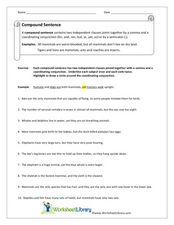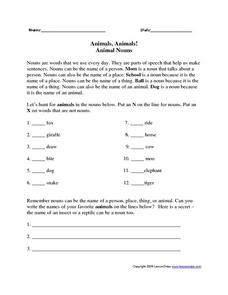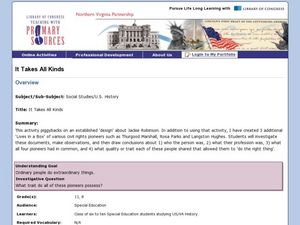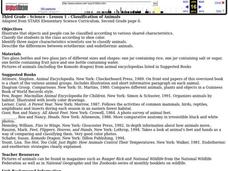Curated OER
Compound Sentence
In this sentence structure worksheet, learners review a definition and examples of compound sentences prior to responding to 10 questions that require them to label the parts of compound sentences.
Curated OER
What's Up at the Rim?
Students are sent on a scavenger hunt to find as many plants as they can in nature.
Curated OER
What Can You Learn About Dinosaurs by Watching an Ostrich?
Young scholars often find dinosaurs interesting. However, it is doubtful that they have actually thought about the process by which scientists (and film animators) develop working models of dinosaurs. Reproducible worksheets provide...
Curated OER
Charles Darwin
For this Charles Darwin worksheet, students fill in the blank with the correct answer. Students use the suggested text to complete statements about Charles Darwin, his expedition, and his development of his theory of evolution.
Curated OER
Animals
Students explore biology by participating in a science vocabulary activity. In this animal species lesson, students define a list of animal vocabulary terms as well as practice using them in sentences with the appropriate adjectives and...
Curated OER
The Sidewinder and the Sidewinder
Pupils compare and contrast the Sidewinder of the U.S. Southwest and the Namib Desert. They watch and discuss a video, complete a journal entry, color templates of both types of sidewinders, and discuss the differences between the two.
Curated OER
Ocean Drifters
Students define terms, and identify three ways in which plankton are adapted for life in the open ocean. For this ocean drift lesson students design a planktonic organism.
Curated OER
Mammals
In this mammals worksheet, high schoolers review terms associated with the different types of mammals. This worksheet has 6 fill in the blank and 4 matching questions.
Curated OER
Animals, Animals!--Animal Nouns
In this animal nouns worksheet, students participate in a hunt for animals. Students look over a list of 12 words and put an N next to each one that is a noun and a X next to each word that is not a noun. Students write the name of 3 of...
Curated OER
Critter Encounter Chart
Students record data found at an assigned web site. In this data collection lesson plan, students access an assigned web site in order to complete a data chart about animals they see. They travel to different sections of the web site to...
Curated OER
Color Crazy
First graders create their own brightly colored animals. In this animal adaptations instructional activity, 1st graders create an animal that is brightly colored but can blend into it's environment.
Curated OER
It Takes All Kinds!
Students view video clips and observe similarities and differences between animals. They sort animals into groups for a zoo. They make a graph of their observations and review scientific classifications.
Curated OER
Let's Sum it Up
Students review facts previously discussed about snakes and lizards and read pages in their science text book about snakes and lizards silently focusing on remembering important facts. They then complete a Venn diagram comparing snakes...
Curated OER
Classification of Animals
Third graders practice classiyfying items and identify three major characteristics scientists use to classify animals. They describe the differences between ectothermic and endothermic animals.
Curated OER
Spy on a Spider
Students view slides or live specimens to name and describe the distinguishing features of groups of arthropods, especially spiders and insects. They complete worksheets, observe webs and then search for and record where spiders can be...
















